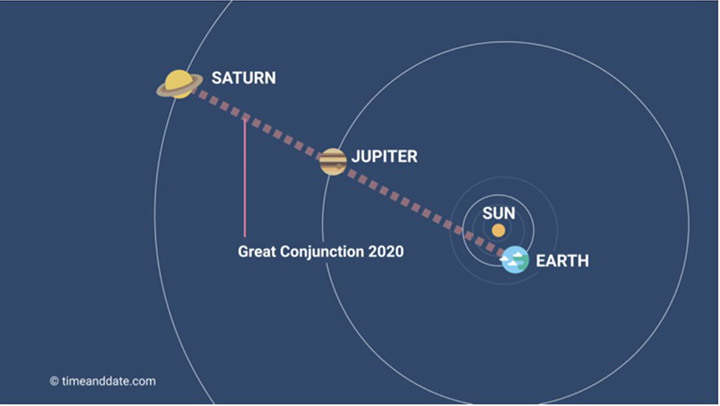Kathrine Alderman
news@greenepublishing.com
The universe has many secrets, and there is much we do not know about space and what exactly we're looking at when we stare up at the stars. Despite all the unknowns about the universe, there are some things science and math have been able to open up for us, even if it's just something cool that we can look up and see because we know it's coming.
On Monday, Dec. 21, Jupiter and Saturn, two of the largest planets in our solar system, will align in what is called the "great conjunction." According to EarthSky, astronomers use the word conjunction to describe a meeting of planets and other objects in our sky. They use the term "great conjunction" to describe the meeting of Jupiter and Saturn, as they are two of the biggest planets.
This year, not only is this one of the closest great conjunctions since 1623, but it is also taking place on the December solstice. This means that the conjunction will be far enough from the sunset that you can actually see the once every 20 years event. In 1623, according to EarthSky, the conjunction that occurred was only 13 degrees east of the sun, closely following sunset, and they consider it unlikely that it was noticed by many people. The closest actually observable great conjunction before that was back in 1226. The next one that will be visible and this close won't be until March 15, 2080. In 2000, at the last great conjunction, Jupiter and Saturn were near the sun in our sky, so it was difficult to see.
This December, Jupiter and Saturn will be only 0.1 degree apart, which is only 1/5 of a full moon diameter. This sight will appear in the western sky just after sunset. You don't have to wait until Dec. 21 to start watching these celestial bodies, however. They are visible tonight and will be near each other for the rest of 2020. Between Nov. 21 and Dec. 21, Jupiter will have traveled about six degrees and Saturn will have traveled three degrees. The movement means that Jupiter will bridge the three-degree gap between itself and Saturn.
Part of the appeal in watching this happen is that both Jupiter and Saturn shine really brightly. When they align, they create what looks like a very bright star, what some this year are calling the Christmas Star. Jupiter by itself is brighter than Saturn by 12 times, and Saturn shines as bright as a 1st magnitude star—some of the brightest stars in the sky—and shines with a distinctly golden color. If you are seeing them before their conjunction, Jupiter will be just to the west of Saturn. The way to distinguish the two planets from stars, other than their brightness, is that, unlike stars, the planets shine steadily and don't twinkle.
According to EarthSky, Jupiter-Saturn conjunctions are the rarest bright planet conjunctions, as Saturn is the farthest and slowest moving planet that we can easily see with the eye alone, while Jupiter is the second slowest bright planet. Saturn takes nearly 30 years to go around the sun full circle, and Jupiter takes about 12 years. So, every 20 years, Jupiter catches up to Saturn as viewed from Earth.
EarthSky breaks down the math of the situation, sharing that it happens every 20 years because each year Saturn completes about 12 degrees of its orbit around the sun, and Jupiter completes around 30 degrees. Therefore, in one year, Jupiter closes the gap by about 18 degrees (30 – 12 = 18). Then, in 20 years, Jupiter gains 360 degrees on Saturn (18 x 20 = 360), lapping it once every 20 years.
In short, after sunset on Monday, Dec. 21, this once every 20 years event will be visible in our night sky. Just because it happens every 20 years doesn't necessarily mean you'll be able to see it next time. Time of day has a lot to do with whether you can actually see the conjunction or not. So, stand out in your yards or wherever you are on the December solstice and view what some are, this year, calling the Christmas Star.

